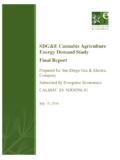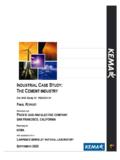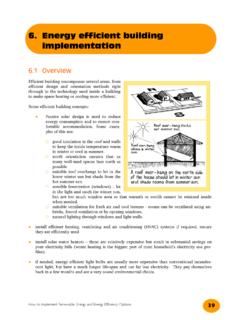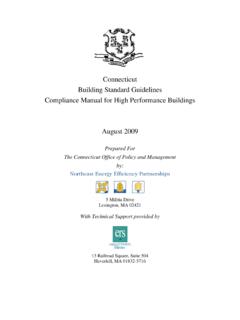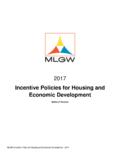Transcription of CALIFORNIA STANDARD PRACTICE MANUAL: …
1 CALIFORNIA STANDARD PRACTICEMANUAL: economic ANALYSIS OF DEMAND-SIDEPROGRAMS AND PROJECTSJuly 2002 Gray Davis, Governor1 Table of ContentsPageChapter Management Categories and Program the : Externality Values and Policy and the Results Can be of the Participant of the Participant Ratepayer Impact Measure and the Results can be of the Ratepayer Impact Measure (RIM) of the Ratepayer Impact Measure (RIM) Resource Cost the Results Can be of the Total Resource Cost of the Total Resource Cost Administrator Cost and the Results Can be of the Program Administrator Cost of the Program Administrator Cost to Equations and of Equations and Glossary of Impact Measure Resource Cost Administrator Cost and Impact Measure Resource Cost Administrator Cost of of Rim Lifecycle Revenue Impact Impact 1 Basic MethodologyBackgroundSince the 1970s, conservation and load management programs have been promoted by theCalifornia Public Utilities Commission (CPUC) and the CALIFORNIA Energy Commission (CEC)as alternatives to power plant construction and gas supply options.
2 Conservation and loadmanagement (C&LM) programs have been implemented in CALIFORNIA by the major utilitiesthrough the use of ratepayer money and by the CEC pursuant to the CEC legislative mandate toestablish energy efficiency standards for new buildings and cost-effectiveness procedures for the CEC standards are outlined in the Public ResourcesCode, no such official guidelines existed for utility-sponsored programs. With the publicationof the STANDARD PRACTICE for Cost-Benefit Analysis of Conservation and Load ManagementPrograms in February 1983, this void was substantially filled. With the informal "adoption"one year later of an appendix that identified cost-effectiveness procedures for an "AllRatepayers" test, C&LM program cost effectiveness consisted of the application of a series oftests representing a variety of perspectives-participants, non-participants, all ratepayers, society,and the STANDARD PRACTICE manual was revised again in 1987-88.
3 The primary changes (relative tothe 1983 version), were: (1) the renaming of the Non-Participant Test to the RatepayerImpact Test ; (2) renaming the All-Ratepayer Test to the Total Resource Cost Test. ; (3)treating the Societal Test as a variant of the Total Resource Cost Test; and, (4) anexpanded explanation of demand-side activities that should be subjected to standardprocedures of benefit-cost changes to the manual captured in this (2001) version were prompted by the cumulativeeffects of changes in the electric and natural gas industries and a variety of changes inCalifornia statute related to these changes. As part of the major electric industry restructuringlegislation of 1996 (AB1890), for example, a public goods charge was established that ensuredminimum funding levels for cost effective conservation and energy efficiency for the 1998-2002 period, and then (in 2000) extended through the year 2011.
4 Additional legislation in 2000(AB1002) established a natural gas surcharge for similar purposes. Later in that year, theEnergy Security and Reliability Act of 2000 (AB970) directed the CALIFORNIA Public UtilitiesCommission to establish, by the Spring of 2001, a distribution charge to provide revenues for aself generation program and a directive to consider changes to cost-effectiveness methods tobetter account for reliability the Spring of 2001, a new state agency the Consumer Power and Conservation FinancingAuthority was created. This agency is expected to provide additional revenues in the form ofstate revenue bonds that could supplement the amount and type of public financial resources tofinance energy efficiency and self generation modifications to the STANDARD PRACTICE manual reflect these more recent developments inseveral ways.
5 First, the Utility Cost Test is renamed the Program Administrator Test toinclude the assessment of programs managed by other agencies. Second, a definition of selfgeneration as a type of demand-side activity is included. Third, the description of thevarious potential elements of externalities in the Societal version of the TRC test is2expanded. Finally the limitations section outlines the scope of this manual and elaborates uponthe processes traditionally instituted by implementing agencies to adopt values for theseexternalities and to adopt the the policy rules that accompany this Management Categories and ProgramDefinitionsOne important aspect of establishing standardized procedures for cost-effectiveness evaluationsis the development and use of consistent definitions of categories, programs, and manual employs the use of general program categories that distinguish between differenttypes of demand-side management programs, conservation, load management, fuel substitution,load building and self-generation.
6 Conservation programs reduce electricity and/or natural gasconsumption during all or significant portions of the year. Conservation in this contextincludes all energy efficiency improvements . An energy efficiency improvement can bedefined as reduced energy use for a comparable level of service, resulting from the installationof an energy efficiency measure or the adoption of an energy efficiency PRACTICE . Level ofservice may be expressed in such ways as the volume of a refrigerator, temperature levels,production output of a manufacturing facility, or lighting level per square foot. Loadmanagement programs may either reduce electricity peak demand or shift demand from on peakto non-peak substitution and load building programs share the common feature of increasing annualconsumption of either electricity or natural gas relative to what would have happened in theabsence of the program.
7 This effect is accomplished in significantly different ways, by inducingthe choice of one fuel over another (fuel substitution), or by increasing sales of electricity, gas,or electricity and gas (load building). Self generation refers to distributed generation (DG)installed on the customer s side of the electric utility meter, which serves some or all of thecustomer's electric load, that otherwise would have been provided by the central electric some cases, self generation products are applied in a combined heat and power manner, inwhich case the heat produced by the self generation product is used on site to provide some orall of the customer s thermal needs. Self generation technologies include, but are not limited to,photovoltaics, wind turbines, fuel cells, microturbines, small gas-fired turbines, and gas-firedinternal combustion substitution and load building programs were relatively new to demand-side managementin CALIFORNIA in the late 1980s, born out of the convergence of several factors that translated intoaverage rates that substantially exceeded marginal costs.
8 Proposals by utilities to implementprograms that increase sales had prompted the need for additional procedures for estimatingprogram cost effectiveness. These procedures maybe applicable in a new context. AB 970amended the Public Utilities Code and provided the motivation to develop a cost-effectivenessmethod that can be used on a common basis to evaluate all programs that will remove electricload from the centralized grid, including energy efficiency, load control/demand-responsivenessprograms and self-generation. Hence, self-generation was also added to the list of demand sidemanagement programs for cost-effectiveness evaluation. In some cases, self-generationprograms installed with incremental load are also included since the definition of self-generationis not necessarily confined to projects that reduce electric load on the grid.
9 For example,suppose an industrial customer installs a new facility with a peak consumption of MW, withan integrated on-site MW gas fired DG unit. The combined impact of the new facility isload building since the new facility can draw up to MW from the grid, even when the DGunit is running. The proper characterization of each type of demand-side management program3is essential to ensure the proper treatment of inputs and the appropriate interpretation of cost-effectiveness programs is important because in many cases the same specific device can be andshould be evaluated in more than one category. For example, the promotion of an electric heatpump can and should be treated as part of a conservation program if the device is installed inlieu of a less efficient electric resistance heater.
10 If the incentive induces the installation of anelectric heat pump instead of gas space heating, however, the program needs to be consideredand evaluated as a fuel substitution program. Similarly, natural gas-fired self-generation, as wellas self-generation units using other non-renewable fossil fuels, must be treated as fuel-substitution. In common with other types of fuel-substitution, any costs of gas transmission anddistribution, and environmental externalities, must be accounted for. In addition, cost-effectiveness analyses of self-generation should account for utility interconnection , a thermal energy storage device should be treated as a load management programwhen the predominant effect is to shift load. If the acceptance of a utility incentive by thecustomer to, install the energy storage device is a decisive aspect of the customer's decision toremain an electric utility customer ( , to reject or defer the option of installing a gas-firedcogeneration system), then the predominant effect of the thermal energy storage device has beento substitute electricity service for the natural gas service that would have occurred in theabsence of the addition to Fuel Substitution and Load Building Programs, recent utility program proposalshave included reference to "load retention," "sales retention," "market retention," or "customerretention" programs.

